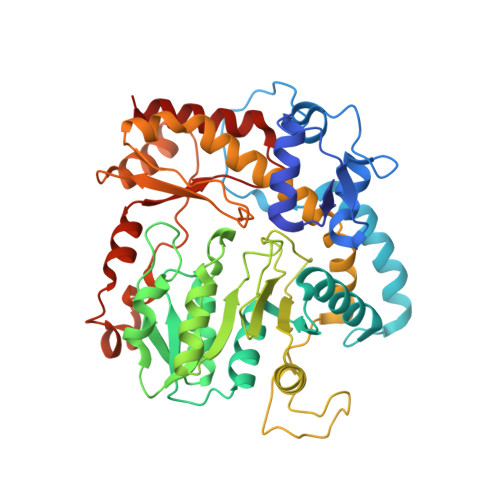Snapshots along the catalytic path of KabA, a PLP-dependent aminotransferase required for kanosamine biosynthesis in Bacillus cereus UW85.
Prasertanan, T., Palmer, D.R.J., Sanders, D.A.R.(2021) J Struct Biol 213: 107744-107744
- PubMed: 33984505
- DOI: https://doi.org/10.1016/j.jsb.2021.107744
- Primary Citation of Related Structures:
7KZ3, 7KZ5, 7KZ6, 7KZD - PubMed Abstract:
Kanosamine is an antibiotic and antifungal monosaccharide. The kanosamine biosynthetic pathway from glucose 6-phosphate in Bacillus cereus UW85 was recently reported, and the functions of each of the three enzymes in the pathway, KabA, KabB and KabC, were demonstrated. KabA, a member of a subclass of the VI β family of PLP-dependent aminotransferases, catalyzes the second step in the pathway, generating kanosamine 6-phosphate (K6P) using l-glutamate as the amino-donor. KabA catalysis was shown to be extremely efficient, with a second-order rate constant with respect to K6P transamination of over 10 7 M -1 s -1 . Here we report the high-resolution structure of KabA in both the PLP- and PMP-bound forms. In addition, co-crystallization with K6P allowed the structure of KabA in complex with the covalent PLP-K6P adduct to be solved. Co-crystallization or soaking with glutamate or 2-oxoglutarate did not result in crystals with either substrate/product. Reduction of the PLP-KabA complex with sodium cyanoborohydride gave an inactivated enzyme, and crystals of the reduced KabA were soaked with the l-glutamate analog glutarate to mimic the KabA-PLP-l-glutamate complex. Together these four structures give a complete picture of how the active site of KabA recognizes substrates for each half-reaction. The KabA structure is discussed in the context of homologous aminotransferases.
Organizational Affiliation:
Department of Chemistry, University of Saskatchewan, Saskatoon, SK S7N 5C9, Canada.

















